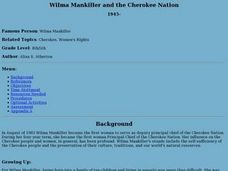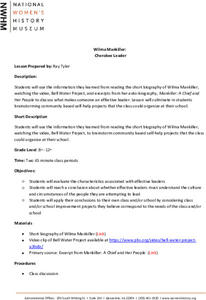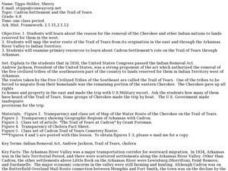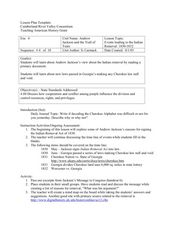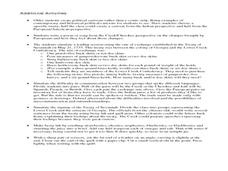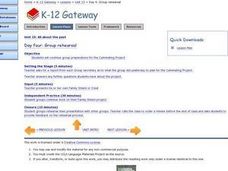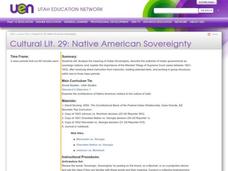Curated OER
Wilma Mankiller and the Cherokee Nation
Students examine how Wilma Mankiller became the first female Principal Chief of the Cherokee Nation. They listen to a teacher-led lecture, write a letter to President Andrew Jackson, participate in a jigsaw activity, conduct research,...
Curated OER
The Cherokee: Trail Where They Cried
Learners read the Trail of Tears about the Cherokee Nation removal and write a letter pretending they are the grandparent of a Cherokee child. In this Trail of Tears lesson plan, students understand the changing of boundaries.
National Woman's History Museum
Wilma Mankiller: Cherokee Leader
Middle and high schoolers consider the characteristics that make for a great leader. For example, they investigate Wilma Mankiller, the first female Principal Chief of the Cherokee Nation. Researchers read a short biography, watch a...
K20 LEARN
Worcester v. Georgia: Cherokee Sovereignty and Actions of the U.S. Government
Young historians study the Supreme Court case "Worcester v. Georgia" and note instances where the Justices defended the sovereign rights of the Cherokee. They also examine the actions of President Andrew Jackson and the...
Curated OER
The Cherokee Removal
Eleventh graders examine the issue of Cherokee removal from the perspectives of Andrew Jackson, members of Congress, and members of the Cherokee nation. They adopt the perspectives and engage in debate over the issue of Cherokee removal.
Alabama Learning Exchange
Would you fit in with the Cherokees?
Students use this activity as an introduction to the unit on Cherokee Native Americans. They discuss and research Cherokee dress and homes and identify difference between the Cherokee and the individuals in the class.
Curated OER
Jacksonian America and the Indian Removal Act of 1830
Students utilize primary sources to explore the national climate concerning Native American Indians during the Andrew Jackson administration. They are presented with opinions for and against the Indian Removial Act of 1830 as they...
Curated OER
Cadron Settlement and the Trail of Tears
Students examine the reason for removal of the Cherokee and other Indian nations. They map the water route of the Trail of Tears from its origination in the east and through the Arkansas River Valley to Indian Territory.
Curated OER
Events Leading to the Indian Removal 1830-1832
Students consider the effects of Indian Removal on the Cherokee Nation. In this American history lesson, students research Internet and print sources regarding the Indian Removal Act of 1830. Students write short stories that detail the...
Race Briges Studio
I am Indopino: Or, How to Answer the Question, "Who Are You?"
In our increasingly multi-ethnic society, many students find it difficult to identify themselves as belonging to any one ethnicity. Gene Tagaban, a Tlingit, Cherokee, Filipino offers his personal experiences with these questions in his...
Curated OER
How the West was Lost-The Trail of Tears
In this Native American history worksheet, students respond to 14 short answer questions about Cherokee removal polices and the Trail of Tears.
Curated OER
Native Lands: Indians in Georgia-Shifting Ground Political Cartoon-Introduction
Students explore the relationship between the Creek, Cherokee, and European/American cultures prior to the American Revolution. Students do Internet research to identify and explain changes in these cultures, then ...
Curated OER
Yours and My Trail of Tears
Students investigate the Trail of Tears. In this United States history lesson, students identify the reason for removing the Cherokee Nation and role play a modern day situation similar to the Indian Removal Act. Students reflect their...
Curated OER
The Trail of Tears; Its Grief and Loss
Fifth graders trace the development and expansion of the US while studying the Trail of Tears. They examine the political factors and analyze the impact the Indian Removal Act had upon a society. They present a case for or against the...
Curated OER
Group Rehearsal
Students study their national and family heritage while working in groups. In this personal history project, students examine the family shield or crest of the teacher while preparing to create and share their own with the class....
Curated OER
Lesson Plan: The Math of Removal
Students consider the plight of those who walked the Trial of Tears. In this Indian Removal lesson, students compare statistics regarding Indian survival rates.
Curated OER
Tribal Sovereignty Mock Trial
Students discuss the issue of tribal/native nation sovereignty. They review the Constitution of the U.S. and discuss how it legally provides for sovereign nations. Then they participate in a mock trial of the 1823 Supreme Court Case...
Curated OER
Native American Sovereignty
Students analyze the meaning of Indian Sovereignty. They describe the authority of Indian governments as sovereign nations, and explain the importance of the Marshal Trilogy of Supreme Court cases between 1821-1832. They examine the...
Curated OER
Trail of Tears
Students discover that the Indian Territory was comprised of many Indian tribes originating from many different locations. They distinguish between the Indian tribes in the Indian Territory.
Curated OER
William Apess and the Mashpee "Revolt" of 1833
Prompt your class with the following question: What was the status of American Indians in Massachusetts during Jackson's presidency? To answer this question, class members will read a series of primary source documents (attached),...
Curated OER
The Trail of Tears; Its Grief and Loss
Fifth graders are introduced to the removal of Native Americans along the Trail of Tears. In groups, they examine the political factors that caused this removal and its effect on society. To end the lesson, they discuss various ways to...
Curated OER
Indian Removal
Fourth graders read The Trail of Tears and create a timeline to show the sequence of events that effected the Native American tribes during Andrew Jackson's presidency. In this Native American lesson plan, 4th graders discuss the...
Curated OER
Expansion and Reform: Applying the Declaration of Independence
Students conduct inquiries and research-acquiring, organizing, analyzing, interpreting, evaluating, and communicating facts, themes, and general principles operating in American history. They use the Declaration of Independence to...
Curated OER
QUIZ SHOW! What were you thinking? What did you say?
Students participate in a game show to share the information they have uncovered about the US expansion policy and how it affected Native Americans.
